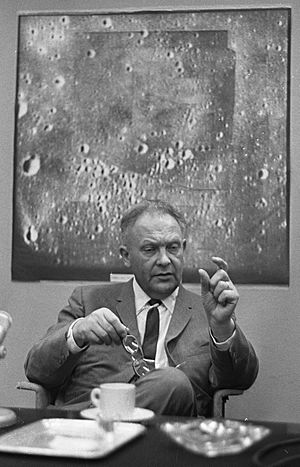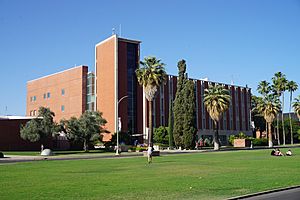Gerard Kuiper facts for kids
Quick facts for kids
Gerard Kuiper
|
|
|---|---|

Gerard Kuiper in August 1964
|
|
| Born |
Gerrit Pieter Kuiper
7 December 1905 Tuitjenhorn, Netherlands
|
| Died | 23 December 1973 (aged 68) Mexico City, Mexico
|
| Nationality | Dutch–American |
| Alma mater | Leiden University (Master of Science, Master of Physics, Doctor of Philosophy, Doctor of Science) |
| Occupation | Astronomer Planetary scientist Selenographer Author professor |
| Known for | Kuiper belt |
| Spouse(s) | Sarah Fuller (1936–1973; his death) |
| Scientific career | |
| Fields | Astronomy |
| Thesis | Statistische onderzoekingen van dubbelsterren (1933) |
| Doctoral students | Carl Sagan |
Gerard Peter Kuiper (born Gerrit Pieter Kuiper; 7 December 1905 – 23 December 1973) was a famous Dutch-American astronomer. He was also a planetary scientist, which means he studied planets. Many people call him the "father of modern planetary science."
Kuiper is especially known for suggesting that there might be a belt of small, icy objects beyond Neptune. This area is now called the Kuiper belt in his honor.
Contents
Early Life and Education
Gerard Kuiper grew up in a small village in the Netherlands. His father was a tailor. From a young age, Gerard was very interested in space and stars. He had amazing eyesight, much sharper than most people. This allowed him to see very faint stars without a telescope!
In 1924, he started studying at Leiden University. This university was a great place for astronomers at the time. He became friends with other students and learned from many famous scientists. He earned his first degree in Astronomy in 1927.
Kuiper finished his PhD in 1933, studying binary stars (two stars orbiting each other). After that, he moved to California to work at the Lick Observatory.
Career and Discoveries
In 1935, Kuiper moved to the Harvard College Observatory. There, he met Sarah Parker Fuller, and they got married in 1936. He later became an American citizen in 1937.
He worked as a professor at the University of Chicago. One of his most famous students was Carl Sagan, who later became a well-known astronomer and science communicator. In the 1950s, Kuiper and Carl Sagan worked together on a secret military project. This project involved studying the Moon.
Moons and Atmospheres
Kuiper made some exciting discoveries about our Solar System. He found two natural satellites (moons) orbiting planets:
He also discovered carbon dioxide in the atmosphere of Mars. In 1944, he found that Titan, a moon of Saturn, has an atmosphere made of methane.
Lunar and Planetary Laboratory
Kuiper spent most of his career at the University of Chicago. But in 1960, he moved to Tucson, Arizona. There, he started the Lunar and Planetary Laboratory at the University of Arizona. He was the director of this lab for the rest of his life. One of the buildings at the University of Arizona is named after him.
In the 1960s, Kuiper helped choose safe landing sites on the Moon for the Apollo program. This was very important for sending astronauts to the Moon.
Honors and Legacy

Gerard Kuiper received many awards for his important work:
- In 1947, he won the Prix Jules Janssen from the Astronomical Society of France.
- In 1959, he received the Henry Norris Russell Lectureship.
- In 1971, he was awarded the Kepler Gold Medal.
Many things in space are named after him:
- A minor planet called 1776 Kuiper.
- Three craters on different celestial bodies: one on Mercury, one on the Moon, and one on Mars.
- The Kuiper Scarp in Antarctica.
- The Kuiper Airborne Observatory, which was a special airplane used for observing space.
The most famous thing named after him is the "Kuiper belt." This is a region beyond Neptune where many small, icy objects and dwarf planets are found. Kuiper was the first to suggest that such objects might exist there.
The Kuiper Prize is a very important award given by the American Astronomical Society's Division for Planetary Sciences. It is named in his honor and is given to top planetary scientists.
Death
Gerard Kuiper passed away from a heart attack on December 23, 1973, in Mexico City. He was on vacation with his wife at the time.
See also
 In Spanish: Gerard Kuiper para niños
In Spanish: Gerard Kuiper para niños

